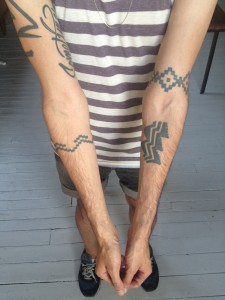Tommy’s first publication was in PANK ‘s Queer Two , October 2011. Entitled “Sucking Famous Dick on the Rooftop of the Omni Hotel in Downtown Austin during SXSW 2011,” it started life as a three-minute sex story. His first chapbook, Absentmindr, is available on iTunes for $0.00 (that’s right, it’s FREE) and you should download it right now, even before you finish reading this interview.
Interview by Julie Hart
On Tommy’s left hand: Kumeyaay, his tribe near San Diego. This is his most recent tattoo, he got it with his brother on his most recent trip home.
Left forearm, a lightning symbol used in Kumeyaay basket design. It scabbed over and he picked at it like he didn’t know you weren’t supposed to, since it was his first, so now it has patchy areas. His brother has the same design on his calf. “Everyone always says tattoos don’t hurt, or you get used to it. Not true. When I’m getting a tattoo, the first pain and the last pain are exactly the same, the same absolutely quantifiable physical pain. Normally I have five hundred ideas crowding my mind at once, jamming the doorway, all trying to get out. When I’m under the needle, only one thought at a time can get through. It hurts, but it’s worth it. The focus is worth it.”
A bit higher, on his left bicep, is a banded basket design which functions like a family crest, on his grandmother’s tombstone, on his cousins’ pow wow dresses.
On the left shoulder: two hearts. These are identical to the two Amy Winehouse had on her other shoulder. He took her death very hard, like she was his sister almost. He was just twenty-seven himself when she died, her age exactly. He felt like he could have been that self-destructive if his life had taken a different course, some of the same capacity for self-sabotage, self-hatred, self-annihilation. He says it’s to remember her. And his former self.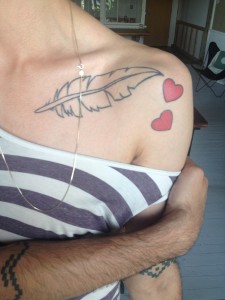
from “Freshmen”
Hunger is a room
to be tended. Emptiness kept.
Every flake, we say, is different.
Next to the hearts on the left collarbone: a feather. Tommy says: “I had eschewed ‘traditional’ American Indian iconography in my poetry for a long time, leather and feathers and beads and pow wows and dream catchers and bear paws and whatnot, because I felt they were reductive and weren’t really mine or my tribe’s anyway. ‘Indian’ was a created identity. I’m not ‘Indian’; I’m Kumeyaay. Like, I told myself I would never use an eagle in a poem. But then I wrote ‘Having Left’ which begins, ‘Like my grandfather, I keep eagles.’ It was a line invoking one of my grandmother’s husbands (not my actual grandfather) named Billy Bird. He was a shaman or kusiyaay and had eagles. And I realized it was a little bit juvenile and maybe even a little bit snobby to look down on these symbols of pan-Indianism, because so much of our collective culture has been flipped, uprooted, destroyed, and for some Indians, especially urban Indians or those who were stolen from their homes and adopted into other families, all they have is the feathers. So it’s more complicated than my first analysis. So I got the feather both to symbolize a quill, my new career, but also taking a traditional symbol and putting it in context with my basket designs.”
from “Having Left”
Who believes in spiritual horseshit?
There is a common misconception
about Indian people, namely everything.but especially sadness.
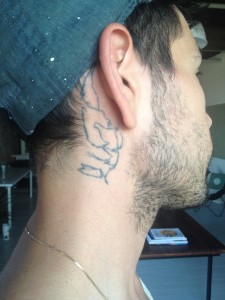 On his neck behind the right ear, you can see an abstract design which is the logo for his hand-stitched zine, “birdsong.” His friend Cara drew this for the back cover of the first issue. Everybody asks him what it is, but it’s not easily identifiable, it’s like a Rorschach test, it’s what you see in it. Later, he asked Cara what it was and she said the design came from a piece of skin she peeled from her foot one day, so—ew!—he almost wishes now he hadn’t asked. Maybe you guys wish I hadn’t told you either! Tommy says: “It’s kind of a big commitment,[a neck tattoo will be visible even if you wear a business suit] but birdsong was a big accomplishment for me. The tattoo symbolized the community of writers and artists I helped create, and also my own work apart from birdsong. I would never have mustered the confidence to write without being surrounded by my friends, but I can now.”
On his neck behind the right ear, you can see an abstract design which is the logo for his hand-stitched zine, “birdsong.” His friend Cara drew this for the back cover of the first issue. Everybody asks him what it is, but it’s not easily identifiable, it’s like a Rorschach test, it’s what you see in it. Later, he asked Cara what it was and she said the design came from a piece of skin she peeled from her foot one day, so—ew!—he almost wishes now he hadn’t asked. Maybe you guys wish I hadn’t told you either! Tommy says: “It’s kind of a big commitment,[a neck tattoo will be visible even if you wear a business suit] but birdsong was a big accomplishment for me. The tattoo symbolized the community of writers and artists I helped create, and also my own work apart from birdsong. I would never have mustered the confidence to write without being surrounded by my friends, but I can now.”
On his upper right arm, where we find another lightning symbol, the biggest tattoo he has. It changes shape depending on which angle it’s viewed from. He says, “It’s like me, a shapeshifter.”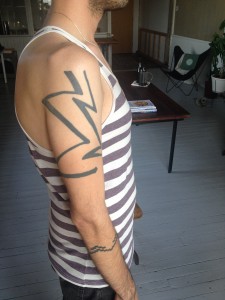
from “Inheritance”
15. There must be a word for this in some romance language, for looking down
at your legs and seeing mom; for looking down at your hands and seeing dad.
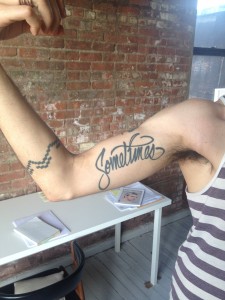 On his inner right bicep: “Sometimes” from a graffito in Bushwick, summer of 2011. He was obsessed with a song of that title his friend Jess Paps had written, was taking photos of all the “Sometimes” tags he could find, working out in his mind all the ways in which he is a sometimes person (see poem in Absentmindr). Sometimes California, sometimes New York, sometimes white (because light-skinned), sometimes non-white. Sometimes he feels like a writer, sometimes he feels like a fraud. Tommy says, “Poetry happens to me when I’m in that situation, maybe like in class or in conversation, when I have an opinion, something to say, and I raise my hand or try to get a word in, but the teacher calls on someone else or the conversation moves on before I get to say my piece. Poetry is where I say what I wanted to say in that situation. There’s probably a word for that in German.”
On his inner right bicep: “Sometimes” from a graffito in Bushwick, summer of 2011. He was obsessed with a song of that title his friend Jess Paps had written, was taking photos of all the “Sometimes” tags he could find, working out in his mind all the ways in which he is a sometimes person (see poem in Absentmindr). Sometimes California, sometimes New York, sometimes white (because light-skinned), sometimes non-white. Sometimes he feels like a writer, sometimes he feels like a fraud. Tommy says, “Poetry happens to me when I’m in that situation, maybe like in class or in conversation, when I have an opinion, something to say, and I raise my hand or try to get a word in, but the teacher calls on someone else or the conversation moves on before I get to say my piece. Poetry is where I say what I wanted to say in that situation. There’s probably a word for that in German.”
On his right forearm, we can see a repeating basket design of a mountain with a cloud over it, a symbol of Viejas mountain, sacred to the Kumeyaay.
Finally, on his lower left thigh: Eesha Kaapa in a scripty font. This is his Kumeyaay name which means birdsong. His father is a bird singer of ancient song cycles accompanied by gourd rattle and dancing that tell Kumeyaay history and the journey to the territory they inhabit now. He says, “Poetry is the way we tell a truth about ourselves. The more attention you pay to poetry, the closer you look at it, the more you get from it. I guess I would say, the more you yield to it, the more it yields to you.”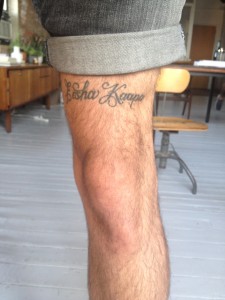
from “One Stop Shop”
It’s like, sugar and booze feel
good, then bad. Sometimes real bad,but art feels bad before it feels
even worse, and then even the best
Tommy says, “I’m always thinking of more tattoos, but before anything else I want to get a line of poetry. I’m not actively seeking out something, but just waiting for the right lyric to appear. I thought for a little bit about getting this Muriel Ruksyser quote: ‘the index of prophesy is light, and steeped therein the world with all its signatures visible’ but that’s kind of long for a tattoo. I’m patient, just waiting and reading.”
from “Life’s a Beach”
Life is waves. . . .
deft kelp evasion . . .
tattoo
pain and the nerve death before a root
canal . . .
life is waves.
***
Originally from Minnesota, Julie Hart has lived in London, Zurich and Tokyo, and now in Brooklyn Heights. Her work can be found in Five Quarterly, Denim Skin, and forthcoming in Floor Plan Journal. @juliehart54***Tommy “Teebs” Pico is the founder and editor in chief of birdsong, an antiracist/queer-positive collective, small press, and zine that publishes art and writing. He’s the author of absentMINDR (VERBALVISUAL, 2014)—the first chapbook APP published for iOS mobile/tablet devices—was a Queer/Art/Mentors inaugural fellow, 2013 Lambda Literary fellow in poetry, and has been published in BOMB, Guernica, and the Best American Poetry blog. Originally from the Viejas Indian reservation of the Kumeyaay nation, he now lives in Brooklyn. Find him at heyteebs.tumblr.com
![[PANK]](https://pankmagazine.com/wp-content/themes/pank/assets/images/pank-logo-large.png)

